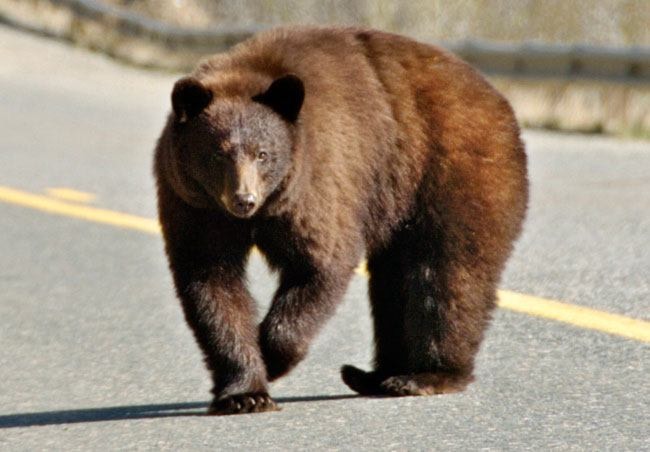She didn’t know it then, but the first time Edna Helm saw the bear, it only had a few hours left to live.
Helm was driving from Carcross to Tagish on the morning of Tuesday, May 21, when she saw a grizzly eating along the side of the road. The bear, a female, had been living near Carcross for years, creating great memories and photo opportunities for tourists and locals alike.
But Helm, a lifelong Carcross resident, had “never bumped into it before,” she said. She saw it that afternoon driving back home. Others also did - a tour bus from Alaska had also stopped to watch the animal, she said.
It’s a good thing they did.
When Helm, a Carcross/Tagish First Nation elder, went to the First Nation’s office the next day, “there was a lot of red-eyed people around,” she said.
The bear had been shot the night before along Tagish Road. It was legal, said David Bakica, the conservation officer who spoke to witnesses last Thursday. The hunter, a Yukon resident, was licensed. It was during grizzly bear season, which runs from April 15 to June 1. If hunters are completely off the road, including paved shoulders of highways, they can shoot animals. They must shoot away from the road, and be at least one kilometre from all residences.
It may have been legal, but it has upset the community, said Danny Cresswell, chief of the Carcross/Tagish First Nation.
The grizzly, estimated to be between six and eight years old, had become a fixture in the area.
“The community just kind of took to the bear,” he said. “It’s kind of like having a pet but not having a pet.”
The bear would wander around the road, eating honeysuckle and watching people, he said.
“It didn’t try to approach people. It just did its own thing. And then it got shot.”
Cresswell last photographed the bear on Sunday. He and his family were driving towards Little Atlin Lake when he saw it. “It was just lying there, had its paws crossed, its head on its paws, and just watching the people and eating some honeysuckle. Yeah, it was quite the little character,” he said.
“And I thought about somebody shooting him, and was like, ‘Nah, nobody’s going to shoot that little guy. It’s not a big bear. It’s not bothering anybody.’”
Now its death has upset residents.
Helm called it a “spirit bear.” Depending on how you looked at it, it seemed completely white, she said.
“It makes you feel so good that there’s such a beautiful animal that’s still alive.
And you’re not going to see one blonde one like that again. Who knows? Maybe never. That colour might not come back,” said Helm. “That’s why I call it a spirit bear. It just uplifted me. It was a gorgeous animal. I still get upset.”
She’s not alone. “They weren’t happy about it,” said Bakica of the community’s reaction to the bear’s death. But they also had some wrong information, he said. Some thought only one grizzly bear can be shot in the territory every year, he said. That’s not true. A licensed hunter can only kill one bear every three years. Residents also thought hunting along the highway was illegal. But it’s not. There are no-hunting corridors along Annie Lake Road and the Takhini Hot Springs Road, he said.
Banning hunting can cause a lot of controversy, said Bakica, especially since First Nation members can’t be stopped from subsistence hunting. Carcross/Tagish First Nation has been opposed to no-hunting corridors, said Cresswell. But the ban along Annie Lake Road makes sense for safety reasons, he added.
“That’s a pretty big debate that would have to happen,” Cresswell said when asked if he thought hunting along highways should have more restrictions.
Some are already discussing if hunting laws should be changed.
Carcross resident Greg Karais started a Facebook page this week, Yukon Hunting Rules Need to Change, to discuss this. He’s not against hunting, and he understands the bear was shot legally, he said. But he doesn’t think it was ethical, he said. If the bear was threatening humans, he wouldn’t be upset it was shot, he said. But it wasn’t. Bears are particularly special; they show how wild the Yukon is, he said.
“It’s part of all those people driving down the road to Carcross hearing, ‘Oh, there’s a bear down there you might be able to see.’ And seeing a grizzly bear for the first time, and putting those smiles on people’s faces,” said Karais.
“Whatever the people of the Yukon decide is the correct course of action is what I will enforce,” said Bakica, when asked if he’d heard about changing hunting regulations.
But nothing can bring back Carcross’s community bear.
He’d never seen one hang around a community like this one did, said Cresswell.
“Next time a bear hangs around, maybe we’ll put up some signs saying ‘Don’t bother the bear,’ ‘Don’t shoot the bear.’”
“If you really want to go hunting, go out in the bush and go hunting,” said Cresswell. “If you want to see a big grizzly, get someone to take you out and really see what a grizzly is.”
Contact Meagan Gillmore at
mgillmore@yukon-news.com
